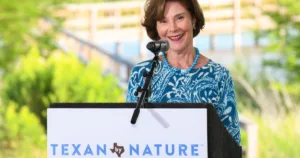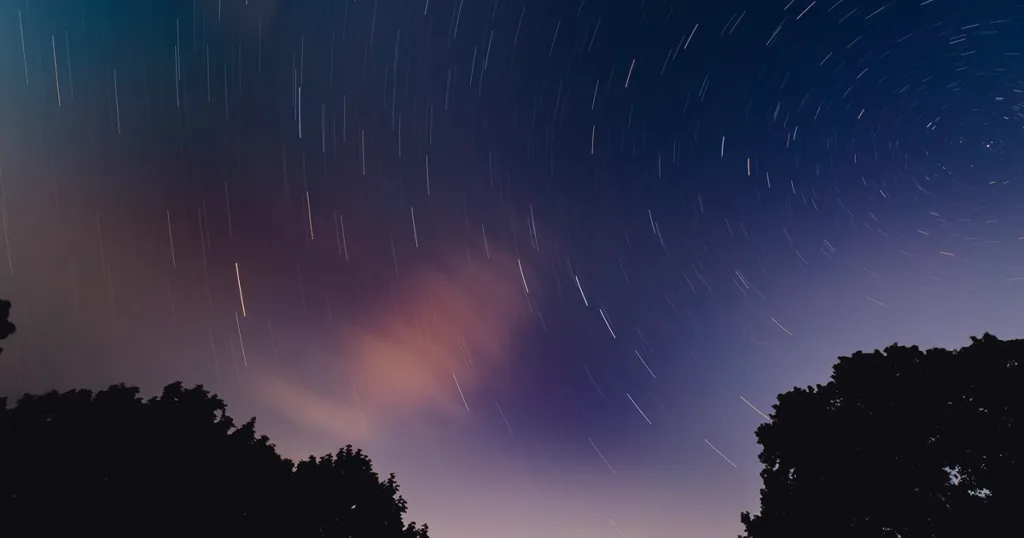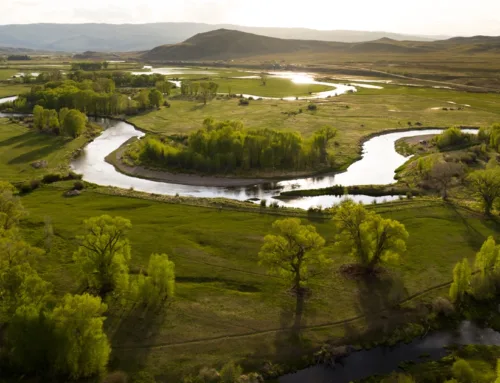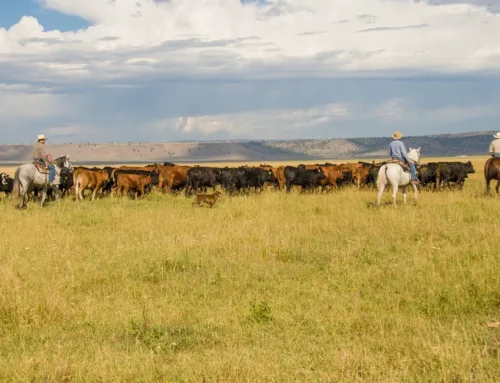Texan By Nature
Texan By Nature
By Lisa Martin

LR_TexanbyNature-01
RESPECT BIG BEND This coalition uses science and scientific methodology to evaluate future energy development in Brewster, Jeff Davis, and Presidio counties.
Decades before she had an inkling of becoming first lady of Texas, let alone the United States, Laura Welch would lie on a blanket beside her mother and gaze up at the birds streaking across the moonlit sky. The memories of those outdoor adventures are some of the favorite ones from her childhood in West Texas, and they invariably include her mother. A self-taught naturalist who lived to age 99, Jenna Welch instilled in her daughter an appreciation for everything from identifying species of native plants and birds to the importance of clean, fresh air.
Fast-forward decades later to January 2009 and the days after George W. Bush’s second term as president came to a close. The Bushes had returned to Texas and were dividing their time between their home in Dallas and their ranch in Crawford two hours away. While the former president began to pen his memoirs, the former first lady set out to rehabilitate the Prairie Chapel Ranch, where they had hosted a variety of world leaders such as Angela Merkel, Vladimir Putin, and Ariel Sharon.
Prairie Chapel Ranch
Rehabilitating the Prairie Chapel Ranch became more than a personal project for the former first lady. It sparked an idea for an innovative nonprofit that supports and spurs conservation efforts across the Lone Star State much like the personal project that she completed at her own ranch.

“I chatted with several of my friends, including my best friend with whom I grew up in Midland, and a few women who grew up on ranches, and we talked about taking care of our state and what we could do,” she tells me during a telephone call from the George W. Bush Presidential Center in Dallas.
“We were interested in Texas – Texas being the leader in conservation – and we got this idea for Texan by Nature,” she adds. Together with her lifelong best friend, Regan Gammon, and Katharine Armstrong of South Texas’s Armstrong Ranch, the trio founded the innovative entity, which celebrates its 10th anniversary in 2021.
Texan By Nature
Shepherded by a small but savvy staff, Texan by Nature has touched every part of the state in the last decade by partnering with more than 100 nonprofit organizations dedicated to various kinds of conservation. Think of Texan by Nature as a matchmaker of sorts.
“From a strategic standpoint, we look at projects as part of a bigger picture and help organizations plug in where similar efforts are taking place,” says Joni Carswell, Texan by Nature’s president and CEO. “We don’t focus on one species, issue, or region, but, instead concentrate our efforts on science-based work and on our role as a strategic resource for industry, civic leaders, landowners, and conservation groups.” She adds that Texan by Nature brings together all of these parties for conversation and action.
Through its signature Conservation Wrangler program, Texan by Nature uses a rigorous application process for selecting nonprofits to assist in various ways over a period of 18 months. For instance, Texan by Nature created a suite of marketing materials for the Texas Playa Conservation Initiative, a program that helps landowners across the Panhandle restore critical playas.
Recharging the Ogallala
The health of playas throughout the Southern High Plains impacts the region’s drinking water. Overgrazing, outdated irrigation systems and practices along with erosion have harmed the integrity of many of the area’s more than 23,000 playas. These shallow basins of water recharge the Ogallala Aquifer – the largest of its kind in the nation – each year at a rate of more than 81,000 gallons an acre.
“Playas are interesting in that they’re not what we think of as your typical wetlands,” says Rachel Fern, a biologist with the Texas Parks & Wildlife Department who oversees the Texas Playa Conservation Initiative. “The dry-out period is actually the most important part of a playa’s life cycle.”
Water typically disappears from the landscape in the warmer months, causing large cracks in the clay layer of the playa. When the rain returns, water that seeps down through the cracks and along plant roots becomes filtered en route to the aquifer. Vegetation on the surface, meanwhile, tends to keep moisture in the soil, which allows it to support life, from invertebrates to waterfowl.
Historically, digging poses the most significant threat to the playa, disrupting the ecosystem and causing water to pool deeply in one area and preventing water from returning to recharge the aquifer. Fertilizers and pesticides from row crops can also pollute the aquifer.
Landowner Incentives
The Texas Playa Conservation Initiative has helped restore more than 2,400 acres of playas, plus an equal amount of surrounding grassland buffer. As an incentive, the initiative offers landowners a one-time payment of $80 an acre for restoring their playas with the stipulation that they not re-pit or dig in the playa for 10 years. The work of restoring playas, which the Texas Playa Conservation Initiative also pays for, typically takes no more than a day or two.
Fern credits Texan by Nature’s outreach materials featuring the former first lady with significantly boosting landowner interest in the program. “Biologists don’t necessarily have the time or the marketing training to reach the masses, so it had been slow getting the word out,” she says.
Program manager Jenny Burden believes the marketing efforts “are helping overcome institutional and historical distrust of government coming onto your property and telling you what to do.”
Given that 95 percent of the state’s 170 million acres is in private hands, wooing landowners is a critical step, particularly in a state where independence is more than a virtue. It’s an identifier, an instantly recognizable trait.
Playa Conservation
Landowners like Darryl Birkenfeld agree. A 30-acre playa sits on his 45 acres a half-mile south of Nazareth in Castro County along FM 168. Birkenfeld surmises that workers building the highway dug a pit in the north side of his playa more than a half-century ago. Thanks to the Texas Playa Conservation Initiative, a crew recently spent two days installing a 10-yard berm to close off the pit.
“People think of playas as a nuisance, because it’s hard to use the land for anything. About two-thirds of them around here aren’t in good shape,” says Birkenfeld, who also serves as executive director of the nonprofit Ogallala Commons, which educates hundreds of area schoolchildren each year about playas and the essential role they play in the local ecosystem.
David Bateman, meanwhile, owns 10 area farms studded with playas ranging from less than 100 acres to more than 500 acres in size. Like many, he discovered the Playa Initiative through word of mouth.
“Playas not only help the aquifer, but they also provide critical food and cover for wildlife,” says Bateman, who operates a hunting club on his land. This recreational income is an essential aspect of his business model. “The more we research and learn about playas, the more we find out how positive they can be,” he adds.
Texas playas occupy a special place in Mrs. Bush’s heart. The 86-acre playa lake outside Midland is now known as the Jenna Welch Nature Study Center. It’s part of a 100-acre riparian forest campus that has become a haven for scientists, students, and nature lovers as well as a habitat for birds, wildlife, and myriad aquatic species.
Central Flyway
In Burden’s role at Texan by Nature, the program manager also began working on the Texas Prairie Wetlands Project in 2018. The project tackles habitat restoration along the central flyway, the temporary home of billions of birds who traverse Texas every spring and fall. In addition, the Gulf Coast remains one of the largest waterfowling areas in the nation.
The project dates to 1991 when Ducks Unlimited first began collaborating with Texas Parks & Wildlife Department, US Fish & Wildlife Service, Gulf Coast Joint Venture, and USDA Natural Resources Conservation Services. The goal of the Texas Prairie Wetlands Project? To offer habitat for wintering waterfowl that improves the birds’ health and increases their rates of survival before they embark on their spring migrations.
Texas Prairie Wetlands Project partners with landowners, especially rice growers, on both water conservation projects and habitat management. The project offers a cost-sharing plan for wetland improvements on private landowners’ farms.
Ducks Unlimited
“Ducks Unlimited built great relationships with landowners on a personal level and does about 3,000 acres of habitat restoration on an annual basis,” says Burden, who helped produce a video explaining the project to landowners. “But it can be a slow process when you’re relying on word of mouth in an area where everyone lives so far apart.”
Texan by Nature also developed GIS (geographic information systems) maps that pinpointed counties eligible for the program and then overlaid them with crop propagation models. The resulting data points gave Taylor Abshier, a private lands biologist with Ducks Unlimited, a better idea of how best to target the group’s outreach efforts.
“Back when the program was created, we knew if we wanted to provide food and habitat on the Gulf Coast, we had to work with private landowners,” he says, noting that the wetland preservation includes services like carbon sequestration, flood prevention, stormwater retention, and water filtration. “Whatever the land use – rice, cattle, recreation – the landowners are passionate about it.”
Wetlands Restoration
In the last 30 years, Texas Prairie Wetlands Project has partnered with approximately 750 landowners and delivered more than 90,000 acres of wetland habitat in 28 counties straddling the Texas Gulf Coast. Landowners must have a minimum of 15 acres of flooded habitat with projects averaging about 75 acres in size.
Landowners also agree to commit to at least 10 years of managing and maintaining wetlands in a way that will provide critical staging and wintering for northern pintails, white-fronted geese, snow geese, green- and blue-winged teal, gadwalls, northern shovelers, and red heads. Year-round resident ducks, including the fulvous and mottled, brood and nest in the wetlands throughout the spring and summer.
On both existing and new wetlands at the 245-acre Camp Orion Hunting Club in Danbury, TPWP built levies and water control level structures. All manner of birds, as well as alligators and a healthy population of otters, make their home below, on, or above the land, which includes a mile of frontage along Austin Bayou.
“The idea was to always have a place for our kids where we could get them outdoors to hunt and connect back to the natural world,” says Billy Barnes, who manages Camp Orion for the group of family and friends that went in together to purchase the property. “New wells made us self-sustaining, meaning we no longer rely on rain or on the county to provide our water. This is now land that can be passed on for generations.”
Respect Big Bend
Safeguarding land for successive generations is also a core value of Respect Big Bend in Far West Texas, where fifth- and sixth-generation landowners are grappling with the implications of energy development, whether it be oil, gas, wind, or solar. With support from the Cynthia and George Mitchell Foundation, Respect Big Bend wants to help coordinate regional planning efforts in order to protect one of the most biodiverse regions on the planet.
This coalition includes community, civic, business, industry, and philanthropic leaders along with landowners. Respect Big Bend uses science and scientific methodology to evaluate future energy development in Brewster, Jeff Davis, and Presidio counties with the intention of shaping decisions made at the highest levels.
“Water, tourism, wildlife, and the culture out in Far West Texas are all critical to the people who live there,” says Texan by Nature program manager Taylor Keys, who has worked with Respect Big Bend since April 2020. “Because nearly all of the land in state is owned by 1 percent of Texans, what happens on that private land is really important for conservation.”
Dark Skies Initiative
With Respect Big Bend, Texan by Nature harnessed expertise gained from its support of the Dark Skies Initiative, a 2018 Conservation Wrangler project that campaigned to have oil and gas companies, businesses, and homeowners dim their lights at night in order to facilitate research at the University of Texas McDonald Observatory in Jeff Davis County.
Mrs. Bush credits much of the effort’s success to oil companies like Apache Corporation, which switched to downlighting on its rigs in the Permian Basin, a move that not only reduced light pollution but also made working conditions safer for the roughnecks. “You don’t really think of oil companies being conservationists, but they’ve helped out a lot,” she says. “Everybody can be a conservationist.”
The relationships forged during the Dark Skies Initiative, which included companies like WPX Energy and Diamondback Energy, have set Respect Big Bend up for success, though the COVID-19 pandemic pushed back its timeline.
“This is such a special area for Texas and for Texans, and it’s important for people around here to have input into what our region is going to look like,” says David Ianelli, who spearheaded efforts to survey local residents and others around the state about their concerns regarding development there.

EOG RESOURCES POLLINATOR HABITAT Monarchs need small, staggered food plots, an ideal use of the millions of acres of oil field right-of-ways in Texas.
Development likewise plays a pivotal role in the EOG Resources’ Pollinator Habitat, a wildlife management program that supports monarch butterflies, which have seen a precipitous decline in population during the last 25 years. In December, the US Fish & Wildlife service made the monarch a candidate for the Endangered Species Act.
Monarch Butterfly Habitat
Two years earlier, Texan by Nature hosted a leadership roundtable with landowners; representatives from the oil, gas, road, and rail industries; and leaders in the seed industry, habitat restoration agencies, and the Right-of-Way as Habitat working group. From those discussions came a plan to restore more than 350 acres of pollinator habitat within the right-of-ways and pad sites that EOG Resources operates, according to Amy Snelgrove, a project and data manager with Texan by Nature.
Monarchs need small staggered food plots throughout their migratory paths, down from the Dakotas and up from Mexico every spring and fall. The distinctive orange and black butterflies only feed on the leaves of milkweed, so EOG Resources devised a way to plant milkweed seed in the Eagle Ford Shale that did not interrupt workflow. Based on the project’s success, the process became standard for the company’s right-of-way restoration efforts.
It’s a win-win for the environment, says Snelgrove, who notes that Texas boasts a total of 14.4 million acres of right-of-ways. “Native grasses have deeper roots and provide an overall benefit to the land both in terms of water and wildlife,” she says.
George W. Bush Presidential Center
Mrs. Bush has a deep understanding of this kind of prairie restoration. In addition to rehabilitating the tallgrass prairie habitat at Prairie Chapel Ranch, she worked closely with Michael Van Valkenburgh Associates on the landscaping for the George W. Bush Presidential Center. Poised on the eastern edge of Southern Methodist University, the museum and library adjoin a 15-acre urban park that features native environments, including Texas Blackland Prairie, Post Oak Savannah, and Cross Timbers Forest. She also planted antelope horn milkweed for her beloved monarch butterflies.
“We’re proud that we’ve never had to use city water to irrigate our park. We collect the runoff from the building and the rainwater into an underground cistern, and we use that to water this huge property in the heart of Dallas,” she says of the center.
Longleaf Pine Restoration
Fostering a healthy ecosystem is the guiding principle of one of Texan by Nature’s newest Conservation Wranglers focused on the eastern part of the state. Selected in March of this year, the Texas Longleaf Implementation Team has set a goal of restoring approximately 15,000 acres of longleaf pine habitat over the next decade. This multidisciplinary network of conservation organizations also intends to enhance or, at a minimum, maintain some 110,000 acres of existing longleaf pine.
A century ago, longleaf pine blanketed millions of acres of timberland from the Piney Woods of East Texas to as far north as Virginia. With the advent of the railroad and a more industrialized approach to forestry, faster growing loblolly pines were deemed a more suitable replacement for the native specie. The shift came with a cost to Mother Nature, putting species such as the Louisiana pine snake, Eastern wild turkey, Bachman’s sparrow, and red-cockaded woodpecker at risk.
Because longleaf pine regenerates naturally, “we call it the forest that keeps on giving,” says Jenny Sanders, who leads the Lufkin-based Texas Longleaf Implementation Team. “When managed correctly, it can be harvested over time and can create a great income stream for landowners.”
Enhancing Biodiversity
Cattle can graze under these trees. The land’s inherent biodiversity increases opportunities for hunting and other recreational income, too. Aesthetics also make longleaf forests especially appealing. The more open canopy characterizing the longleaf allows sunlight to reach the forest floor, which, in turn, attracts pollinators and other wildlife.
Sanders and the 18 official partners of the Texas Longleaf Implementation Team hope Texan by Nature will generate new funding sources and partners. Since 2014, the team’s cost-share program with landowners has invested $1.1 million and planted 5,000 acres of new longleaf forest. The bulk of those funds, however, doesn’t go to seedlings. They go to prescribed burns; to date, the nonprofit has funded 23,000 acres of such controlled burns.
“The challenge we are facing is that we’ve got more interest in the program than we have dollars to spend,” says Sanders. “Right now I have $150,000 in no-brainer projects applying for the program and only $80,000 to spend.”
Conservation Summit
Texan by Nature’s board and staff create opportunities for networking with potential funders. The pandemic pushed back the organization’s 2020 Conservation Summit to April 20, 2021. Held at the Bush Center in Dallas, these annual conferences are composed of equal parts conservation leaders and industry leaders.
“We don’t have typical conversations because most of the time these groups don’t ever have an opportunity to mix and learn from one another,” says Carswell, who has served as CEO for three years.
Discussion topics include everything from measuring return on broad conservation projects to how to set up truly mutually beneficial and financially rewarding partnerships between disparate groups like nonprofits and businesses. The summits also highlight the Texan by Nature 20, an annual program recognizing companies across 12 industries that support conservation in innovative ways.
The Next Decade
Over the last decade, Texan by Nature has built a repository of knowledge and information about conservation while forging alliances with businesses based on trust. Its reputation has grown, too, with out-of-state companies and nonprofits seeking Texan by Nature’s expertise. But no one at the organization seems intent on taking a bow just yet. They say they have too much work to do in a state that boasts the 10th-largest economy in the world but spends less than 1 percent of its GDP on conservation projects.
“We see ourselves as a true accelerator of the great conservation work being done in Texas,” says Carswell.
“Texans love our state,” says Mrs. Bush. “And I really do think Texans want our state to be as clean and as beautiful as it can possibly be.”

DARK SKIES INITIATIVE Decreasing light pollution from the Permian Basin as a critical objective of this 2018 program.
Originally published in The Land Report Texas 2021.






